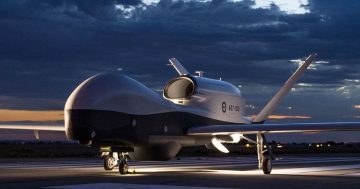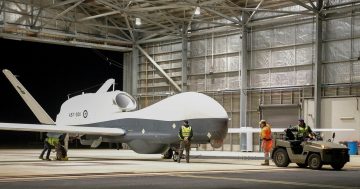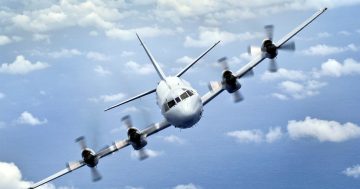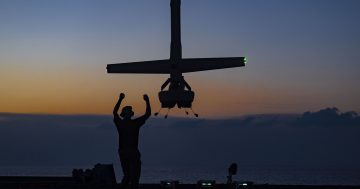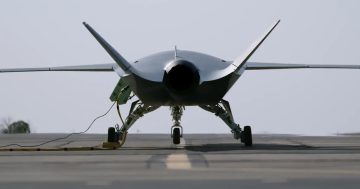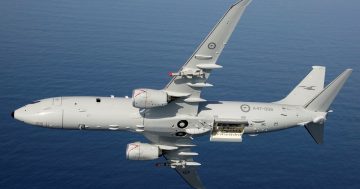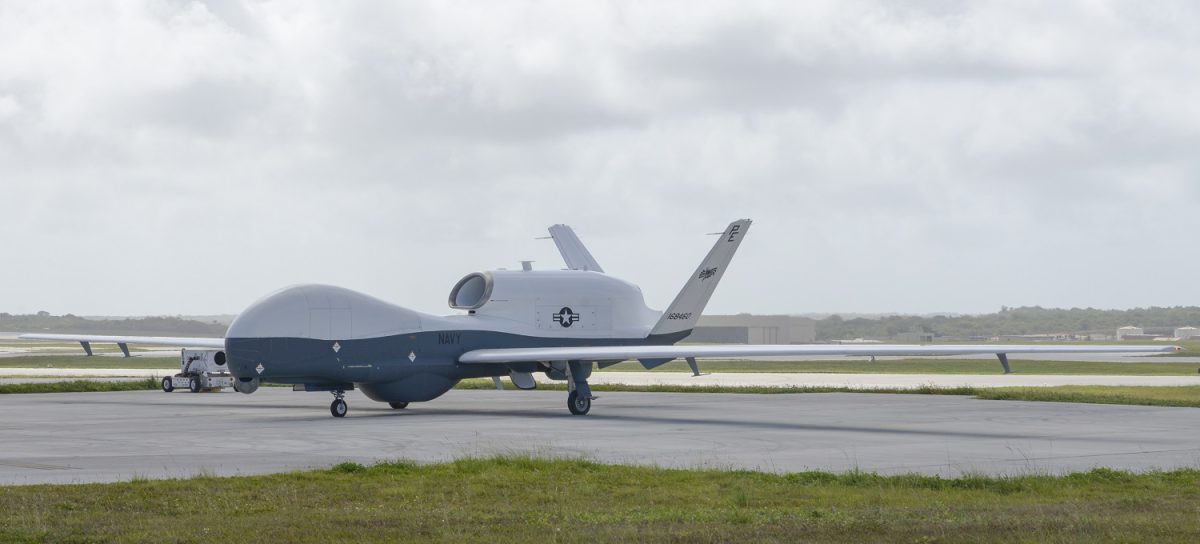
An MQ-4C Triton at Andersen AFB on the western Pacific island of Guam. Photo: US Navy.
The government has announced it will buy a fourth Northrop Grumman MQ-4C Triton uncrewed maritime reconnaissance aircraft for the Royal Australian Air Force.
The announcement of the fourth Triton comes just a week after the US Navy declared it had achieved an initial operational capability (IOC) with the aircraft. IOC is a key milestone for all new military systems, meaning they are capable of being operated and maintained at a normal operational tempo.
The US Navy’s IOC milestone was achieved five years later than planned, and coincided with the delivery of the first two operational Tritons in the operational Integrated Functional Capability (IFC)4 sensor configuration, which includes the advanced Multi-INT electronic intelligence sensor package.
“After assembling lessons learned from Triton’s initial deployment to Guam, the MQ-4C received significant updates including an upgraded sensor suite,” US Naval Air Forces said in a 13 September release.
“With these upgrades, the MQ-4C has the capability and capacity to extend the maritime domain awareness for the US and our allies and partners in the region,” it said.
But the declaration of IOC is somewhat of a bitter pill for the US Navy, with confirmation of reports in May that it has reduced the number of Tritons it had planned to acquire from 68 to just 27 aircraft, including five development airframes that will likely be suitable only for training.
“This quantity reduction is based on the Joint Requirements Oversite Council re-evaluation of worldwide ISR&T (intelligence, surveillance, reconnaissance, and targeting) requirements that resulted in direction to reduce total MQ-4C deployable locations from five to three,” a US Navy spokesman told Seapower magazine in May.
This was confirmed with the recent release of the US Defense Department’s Fiscal Year 2024 budget proposal, which funds just two Tritons in 2024, and then zero aircraft in each of the following four fiscal years.
While the reasons for the US Navy’s scaling back of its program aren’t clear, with the glacial pace of its Triton program since 2005, it’s possible that more advanced uncrewed reconnaissance platforms are planned or are nearing service entry.
The Triton has an advanced and highly capable sensor suite including a maritime radar, electro-optical/infrared camera, and Multi-INT electronic intelligence package. But the high-flying airframe is slow, isn’t stealthy, and is not at all manoeuvrable against possible long-range threats.
The US Navy will also reduce its five planned Triton operating bases to just three, but has not nominated which three of the originally planned five bases in Guam, California, Florida, Italy and the Persian Gulf it will retain.
With the Royal Australian Air Force being a cooperative development partner with the US Navy in the Triton program, this also means the system’s cost of development will now be amortised across a much smaller fleet of just 33 or fewer jets instead of the 76 that were planned, hinting at a possible cost increase per aircraft and for spare parts.
The RAAF’s first Triton was scheduled to have made its first flight in ‘mid-2023’, but industry sources have suggested this is yet to occur. This is likely attributable to a 12-month delay which was inserted into the program by the Albanese government in its October 2022 budget and which was ratified in the May 2023 budget.
The RAAF’s latest order is the fourth of a planned six aircraft, but with US Navy production funding due to end in the 2024 financial year which runs from October 2023 to September 2024, it may not be possible to fit two more Australian aircraft in before production ends. What effect this would have on the RAAFs’ operational plans remains to be seen, but it would likely mean a reduced rate of effort.
The aircraft will be operated by No 9 Squadron, with pilots and sensor operators located at RAAF Base Edinburgh near Adelaide. The aircraft themselves will primarily be based at RAAF Tindal in the Northern Territory where they will be maintained by Northrop Grumman and RAAF personnel, with deployments to the Cocos Islands in the Indian Ocean, and possibly as far northeast as Guam in the Western Pacific.
“The purchase of an additional Triton will enhance operations from Australia’s northern bases, a priority under the Defence Strategic Review,” Defence Industry Minister Pat Conroy said in a 19 September release.












